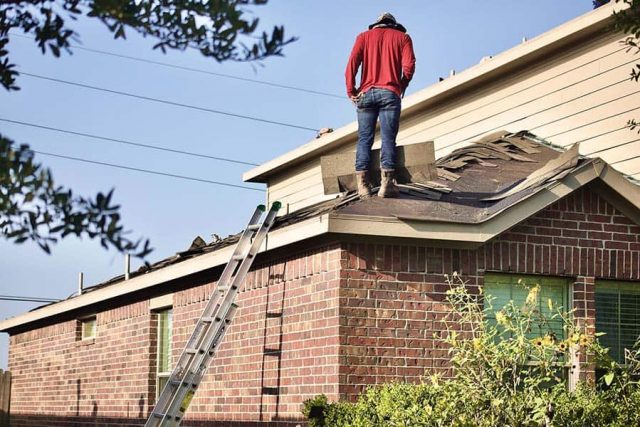Roof care is intimidating, but that doesn’t make it any less important. Your roof protects you as well as your belonging from the elements, so it’s important that you keep it in good condition, especially if you want it to last long. Regular inspections and regular, preventative maintenance prolong the lifespan of your roof, meaning that you don’t have to spend an arm and a leg on roof repairs that are caused by a variety of additional problems. But how should you go about regular maintenance and repairs? Here are a couple of things we suggest to ensure you do it right.
1. Hire A Professional
Sometimes the best way to ensure that the job is done right is to get a professional to do it for you. Professional roofing repair contractors will know exactly what to do and how to ensure that your roof stays fixed for longer. They will also know if you simply need to repair something, or if you need to replace a portion of, or your entire roof. One of the biggest reasons people choose to go with a professional is because with them you have peace of mind that the job was done right. They specialize in a variety of different roofs, which is especially helpful when you don’t know what sort of roof you have, or what to look for because there are quite a few things that need to get done.
2. Clean and Maintain your Gutters
If you are doing maintenance on your own, an important thing you need to keep an eye on is your gutters. By keeping the gutters clean, you keep water away from your roof and prevent water damage to your home. Gutters aren’t there to be decorative. They have an important function to carry out, so removing leaves and checking for blockages needs to be done regularly, especially if you have trees near your home. If you don’t have too many trees near your home, you’ll still need to clean your gutters. Do this at least twice a year to keep things working correctly.
3. Remove Leaves and Debris
Your gutter isn’t the only thing that needs to be cleared of plant debris. Not all of the leaves that blow onto your roof find their way to the gutter. Leaf build-up can cause all sorts of unseen issues that can turn into big problems if left untreated. Moss, lichen, and algae thrive in the damp environment created by leaf piles, weakening the integrity of your roof. You need to regularly check your roof for leaves and other plant debris build-up, and remove it before it becomes a problem.
4. Understanding Sun Exposure
Understanding how the sun affects your roof plays an important role in maintenance, and gives you the necessary knowledge on how to take correct care of yours. Too much sunlight as well as too little can have a very bad impact on the condition of your roof. Excessively hot sun can heat the roof too much causing tiles to crack and other protective oils to dissipate far quicker than they should. Too little sun and your risk of moss, algae, and lichen growth increase exponentially. It is a good idea to talk with a professional about how you can offset any of these issues.
5. Inspect Shingles
Each season brings with it a new set of challenges that are unique to the weather that comes with it. Hot months bring excessive sun damage and depending on where you live, colder months bring rain and even snow. It is important that you check your shingles each season to make sure that they are in good condition. If you do not check them for signs of wear and tear between warmer and colder months, you risk them becoming extremely damaged resulting in leaks. It is best to fix any issues you find – big or small – as soon as you find them to prevent bigger problems.
6. Inspect Your Flashings
To prevent leaks around things like your chimney, vent pipes, and even a sunroof, you need to inspect the flashings. You can do this around the same time you’re inspecting your shingles, but you’ll only need to replace the caulk on an annual basis to prevent water from getting in. While carrying out an inspection, be sure to check if any of the caulking is missing or starting to lift up in places. If you notice a serious issue you can scrape away the old caulk and apply a new bead to fill the gap right away.
7. Treat Moss, Algae, and Lichen Growth
We’ve mentioned that moss, algae, and lichen growth is bad, but we haven’t really gone into detail. They eat into your roof, destroying the structural integrity and causing leaks and the need for new roofing materials. You should treat moss, algae, and lichen at least once a year to prevent excessive and manageable damage. Products containing zinc and copper keep moss away best, and when applied to a clean and dry roof should take care of the issue in no time.
8. Trim Branches
Another way to minimize moss growth is to trim back the trees near your roof. This means fewer leaves and other debris. If you have branches too close to your roof, they could break off in a storm, or worse – they could damage your roof and lift shingles.
9. Insulation
It isn’t just about what’s on the outside. Proper insulation is important, too. If you live somewhere with snow, having good insulation could save your roof from some serious damage. Poor insulation means that too much heat will rise up and escape through your roof. This leads to the base layer of snow melting and refreezing over and over. This process happening over and over can damage your shingles and roof pretty quickly. The right insulation stops too much heat from leaving and prevents this thawing and refreezing cycle from happening on repeat.
When it comes to maintaining your roof there are a few things you need to keep in mind. Doing regular checks and regularly replacing things that need to be replaced is important in order to prevent damage and leaks. You could do it on your own, but to ensure you get the best quality results, check things out for yourself and then call in a professional to come and do the hard work













